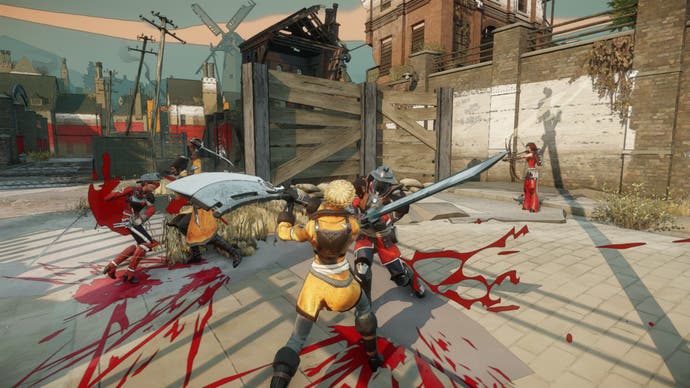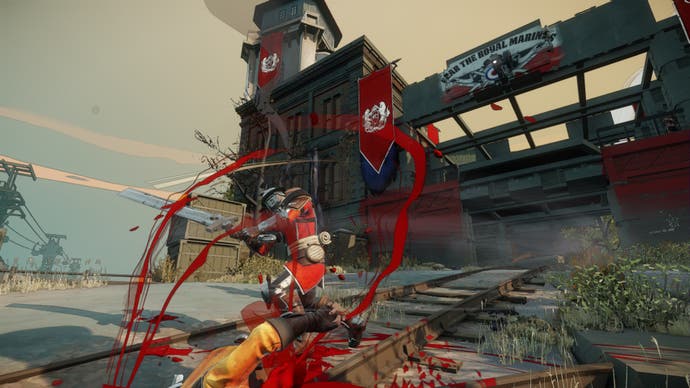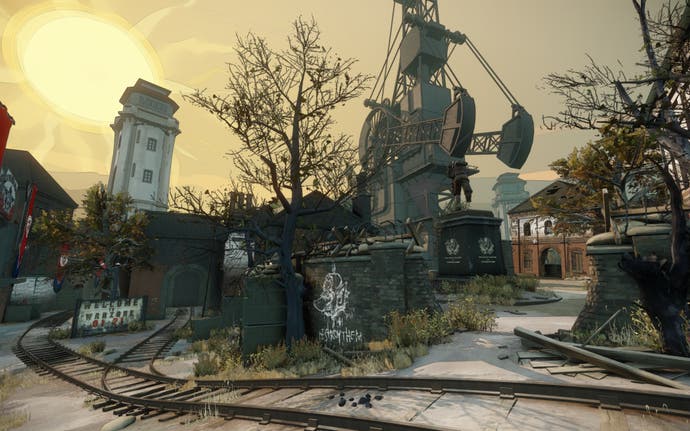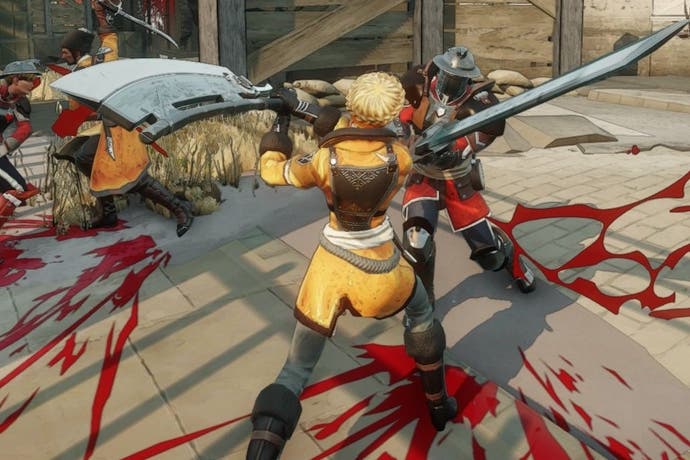Hands-on with BattleCry, Bethesda's new multiplayer F2P action game
32-player team combat, no guns allowed.
If you were going to assemble a team to design a new action game for the PC hardcore, you wouldn't go far wrong with the names Bethesda Softworks has assembled at its new BattleCry studio.
The team is headed up by Rich Vogel, the industry veteran whose MMO experience stretches from Meridian 59 and Ultima all the way up to Star Wars: The Old Republic. Joining him are design director Lucas Davis, whose credits include Halo 4 and Call of Duty: Black Ops 2, and creative director Viktor Antonov, the visual stylist who famously created Half-Life 2's City 17 and Dishonored's ominous sprawl. Blend their previous credits together and you'll have a broad idea of what to expect from BattleCry's first game, also called BattleCry.
"BattleCry is a new breed of multiplayer," says Davis, introducing the game at Bethesda's pre-E3 showcase. It's a 32-player team combat game with an alternate history twist. Set in a world where gunpowder is outlawed, it pits teams representing different countries against each other in enclosed warzones where international disputes are now resolved. Victory in the warzones translates into progression in a larger worldwide battle for supremacy being fought between the factions.
For Vogel, the idea for the game came not from the usual online multiplayer sources, but by looking at what was popular in single-player games and seeing if it could be translated to online.
"We got our inspiration from Devil May Cry, God of War and Arkham Asylum," he explains. "Those are the games we use for what our combat loop will look like. Using those three games as our base, I wanted to build a game that had intimate, visceral combat. When we looked at the field out there, I didn't want to build another FPS. It's very competitive, very hard to get into. No way, I'm not going to do that. I looked at MOBAs, but I didn't want to do a me-too MOBA. There's too many of those coming out. I didn't want to do a combat RPG or action RPG, because there are a lot of those coming out too. Has anyone really done an action combat multiplayer game? We sat down and we all tried to come up with one. No one has done one."
That might come as news to people playing War of the Vikings, but it's easy to see his point. There's a niche here that is chronically underserved.
For the purposes of the demo available for hands-on play, the factions are the British-themed Royal Marines and the Russian Cossack Empire. Neither looks how you'd expect them to, given their names. Instead, Antonov has taken historical stereotypes and given them a steampunk tweak. In the absence of ballistic weapons, these rival imperial forces have taken sword and bow designs to the next level using what Davis refers to as "pansophic technology".

This is most obvious in the weaponry carried by the Enforcer class, the game's tank equivalent. Enforcers are muscular hulks who carry enormous broadswords which can be swung in a variety of deadly arcs and thrusts. But the sword isn't just a sword. Its alternate fire mode makes it ker-chunk-a-chunk outwards to form a mobile shield.
There's also the Duellist, the game's thief/rogue equivalent, armed with dual short swords and the ability to cloak for a limited time. There's also the Tech Archer, who offers the game's only ranged attack. Whether wielding advanced longbows or crossbows, this is the only class that offers anything like shooting, though they also have throwing daggers to deal with close and personal encounters. There will be two more classes in the finished game - Brawlers (the concept art for which resembles Tom Hardy in Bronson mode) and the Gadgeteer support class.
Characters are fairly nimble. Not quite as agile as Titanfall's wall-running pilots, but certainly capable of more vertical movement than most multiplayer protagonists. Of particular note is the proliferation of grapple points across the map, offering quick routes up and down the game's structures.
We're given access to Fracture, a map set in a ruined mining town in Northern England, for a few rounds of team deathmatch. Movement is certainly action-game slick, but finding the pulse of the game's curious take on melee fighting takes time. There doesn't appear to be much nuance, or indeed much skill, involved in getting a kill. Encounters tend to involve everyone running at each other, hacking and slashing away with no real accuracy or strategy. That's almost certainly down to the inexperience of the assembled journalists playing, but nor is it obvious where tactics for deeper play would grow from. With only one player class that can block - the Enforcer - it seems inevitable that battle will tend towards chaotic scrums.

"It's a huge challenge," admits Vogel. "The first six months of development, we have to get the fun. We have to get that core combat loop there, or we're done. Ranged versus melee, we all know how hard that is to get right, we know how hard it is to get in a single area on a map. That was our biggest challenge, to get ranged and melee where people will not always migrate to melee, or feel that ranged is overpowered either."
One particularly nice touch, and one that has been specifically introduced to try and avoid the sort of toxic community that online games tend to attract, is that after each match you can earn bonus in-game currency (or Iron as it's called in BattleCry's world) by finding the top-rated players on the map and saluting them. There's another opportunity during the post-match highlights, presented as old newspaper covers, where you can bestow medals on players and honour them as well. Whether that will be enough to actually bind the players together, or whether it'll be a hollow gesture that players blitz through while screaming abuse at each other, remains to be seen. At least they're trying to address the issue through play mechanics, and in a witty fiction-appropriate way to boot.
Another pressing issue is the decision to make the game free-to-play. It's clearly something Rich Vogel is anticipating in every interview, as he jumps straight in before the question has left my lips. "Our philosophy is really clear," he says, emphatically. "Our whole goal with this game is we will not have gates. We will not have the ability to pay to advance in this game. You can earn Iron, and you can use that Iron to develop and advance. We're not going to stop you from getting in areas, we're not going to stop you advancing so you have to pay. That's not our philosophy at all."
Though the final decision as to what the in-game store will carry has yet to be made, Vogel has a clear idea of the sort of content they're looking at. "When we offer something for someone to buy, we want it to have value to them. We're not going to force it on you. You'll be able to dress your warrior, buy badges for your warrior, there's all kinds of vanity things we're thinking of. There'll be convenience items, that maybe let you have a time-limited buff or whatever."

BattleCry's looks match its idealism, with a heightened and colourful design that is reminiscent of Team Fortress 2. Neat environmental details abound, such as the stylised painterly sun blazing across the sky, and the way the game uses its draw distance to gradually fade details out into abstract shapes is both a cunning technical workaround and a charming visual flourish.
It's also a game that feels like it could easily work away from the PC, and Vogel can't help but suppress a smile when I ask about platform availability, as Sony and Microsoft loosen their approach to F2P titles. "Right now we're only talking about PC," he says, before coughing theatrically and motioning towards the Xbox controllers that we've been using to play the game. "But action games are so intuitive for a console player. You know that. I know that. You can see where it's heading. That's all I can say right now."
BattleCry (the studio) was founded in 2012 but BattleCry (the game) is still a long way from release. In its current embryonic form, it's very playable and pretty good fun, though it will need a lot more gameplay depth and long-term progression options if it's going to really grab players. The developers are currently talking about holding the first beta trials next year, though, so it's far too early to use a handful of matches as any real indicator of what the finished game will be like once all the classes and upgrades are implemented and balanced.
What these brief glimpses do illustrate is intent, and BattleCry's team seems absolutely genuine in its desire to do something different in the F2P multiplayer market, and clearly very aware of the hurdles it faces in getting there. With a handful of intriguing ideas, and a surplus of ambition, if nothing else BattleCry will be one to watch for in 2015.
This preview is based on a trip to a press event in Los Angeles. Bethesda paid for travel and accommodation.




.png?width=291&height=164&fit=crop&quality=80&format=jpg&auto=webp)




.jpg?width=291&height=164&fit=crop&quality=80&format=jpg&auto=webp)
